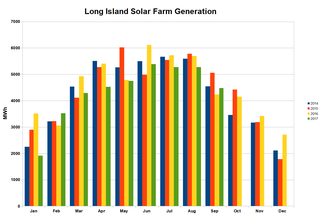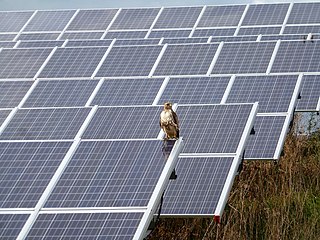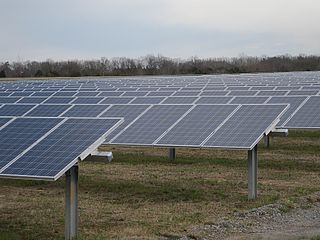
Solar power is a fast-growing industry in Australia. As of December 2022, Australia's over 3.36 million solar PV installations had a combined capacity of 29,683 MW photovoltaic (PV) solar power, of which at least 3,922 MW were installed in the preceding 12 months. In 2019, 59 solar PV projects with a combined capacity of 2,881 MW were either under construction, constructed or due to start construction having reached financial closure. Solar accounted for 12.4% of Australia's total electrical energy production in 2021.

Conergy was a multinational renewable energy company headquartered in Singapore. It was founded in Hamburg, Germany in 2000 by former CEO Hans-Martin Rüter, and specialized in the development, operation and maintenance of photovoltaic power plants and plant components.

Wemen is a locality in Victoria, Australia, located approximately 110 kilometres (68 mi) from Mildura, Victoria.

Topaz Solar Farm is a 550 megawatt (MWAC) photovoltaic power station in San Luis Obispo County, California, United States. Construction on the project began in November 2011 and ended in November 2014. It is one of the world's largest solar farms. The $2.5 billion project includes 9 million CdTe photovoltaic modules based on thin-film technology, manufactured by U.S. company First Solar. The company also built, operates and maintains the project for MidAmerican Renewables, a Berkshire Hathaway company. Pacific Gas and Electric will buy the electricity under a 25-year power purchase agreement. According to First Solar, it created about 400 construction jobs.
The Davidson County Solar Farm is a 17.2 megawatt solar power station located in the heart of North Carolina, near the community of Linwood. SunEdison built the array of photovoltaic panels, and Duke Energy buys all the output from the solar farm. The solar farm is located on North Carolina Highway 47, off New Jersey Church Road.

The energy sector in Hawaii has rapidly adopted solar power due to the high costs of electricity, and good solar resources, and has one of the highest per capita rates of solar power in the United States. Hawaii's imported energy costs, mostly for imported petroleum and coal, are three to four times higher than the mainland, so Hawaii has motivation to become one of the highest users of solar energy. Hawaii was the first state in the United States to reach grid parity for photovoltaics. Its tropical location provides abundant ambient energy.

A photovoltaic power station, also known as a solar park, solar farm, or solar power plant, is a large-scale grid-connected photovoltaic power system designed for the supply of merchant power. They are different from most building-mounted and other decentralized solar power because they supply power at the utility level, rather than to a local user or users. Utility-scale solar is sometimes used to describe this type of project.

The 32 megawatt AC Long Island Solar Farm (LISF), located in Upton, New York, was the largest photovoltaic array in the eastern U.S. in November 2011. The LISF is made up of 164,312 solar panels from BP Solar which provide enough electricity for roughly 4,500 households. The project will cause the abatement of more than 30,000 metric tons of carbon dioxide emissions per year. LISF is co-owned by BP Solar and MetLife through Long Island Solar Farm LLC. Municipal utility Long Island Power Authority (LIPA) buys the 37-megawatt (49,600 hp) power plant's output, which is estimated at 44 GWh annually, under a 20-year power purchase agreement (PPA). Payments over that time are expected to total $298 million. The project was engineered by Blue Oak Energy and construction subcontracted to Hawkeye LLC from Hauppauge, New York. The plant earned the Best Photovoltaic Project of Year Award from the New York Solar Energy Industries Association. The panels are mounted at a fixed tilt angle of 35°, with the rows spaced approximately 18 ft 4 in (5.59 m) apart.
Solar power has been increasing rapidly in the U.S. state of North Carolina, from less than 1 MW (megawatts) in 2007 to 6,152 MW in 2019, and has the second-largest installed PV capacity of all states. SunEdison built a 17.2-megawatt solar farm in Davidson County.

Solar power in Michigan has been growing in recent years due to new technological improvements, falling solar prices and a variety of regulatory actions and financial incentives. The largest solar farm in Michigan is Assembly Solar, completed in 2022, which has 347 MW of capacity. Small-scale solar provided 50% of Michigan solar electricity as recently as 2020 but multiple solar farms in the 100 MW to 200 MW range are proposed to be completed by the middle of the decade. Although among the lowest U.S. states for solar irradiance, Michigan mostly lies farther south than Germany where solar power is heavily deployed. Michigan is expected to use 120 TWh per year in 2030. To reach a 100% solar electrical grid would require 2.4% of Michigan's land area to host 108 GW of installed capacity.
Solar power in Kentucky has been growing in recent years due to new technological improvements and a variety of regulatory actions and financial incentives, particularly a 30% federal tax credit, available through 2016, for any size project. Kentucky could generate 10% of all of the electricity used in the United States from land cleared from coal mining in the state. Covering just one-fifth with photovoltaics would supply all of the state's electricity.

Solar power in Tennessee is capable of producing much of the state's electricity; however, the industry remains in early stages in the state. With 129 MW of solar power in 2015, Tennessee ranked 20th among states for installed solar capacity.
WIRSOL Solar AG is an international solar energy provider, specialized in the planning, financing, construction and maintenance of solar power plants of any size. The headquarters of the company is in Germany. Further company offices are located in Spain, Italy, Great Britain, Belgium, Switzerland, Canada, USA, China, Malaysia and the Maldives.
Güstrow Solarpark is a 31-megawatt (MW) photovoltaic power station near Güstrow, Germany. It was built on the site of a former sugar factory and covers an area of 75 hectares.
Gannawarra Solar Farm is a photovoltaic solar power station in the Gannawarra Shire, 13 kilometres (8.1 mi) west of Kerang in the Australian state of Victoria. It generates up to 60 MWdc electricity and exports up to 50.61 MWAC to the National Electricity Market at 66 kV.
Gannawarra Energy Storage System (GESS) is a grid-connected energy storage system adjacent to the Gannawarra Solar Farm in Wandella in the Shire of Gannawarra, 14km west of Kerang.
Project Fortress is a photovoltaic power station under construction in the UK. It is sited on the Graveney marshes between Faversham and Whitstable, Kent in the UK. It will generate 350MW of electricity from 900 acres (360 ha) vertical solar panels and will feature 700MWh of battery storage. Because of its size, it is a nationally significant infrastructure project so outside the standard local planning procedure.









